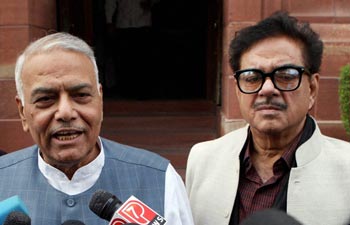
New Delhi, November 26: The BJP's top leadership will meet today to discuss growing rebellion in the party, a day after it suspended Rajya Sabha member Ram Jethmalani for his vocal dissent, first on party president Nitin Gadkari's continuance and then on the issue of the appointment of the new CBI chief.
At the meeting of the party's Parliamentary Board at 4:30 pm today, BJP leaders are also expected to decide on action against other rebels like Yashwant Sinha and Shatrughan Sinha. Both these leaders have, along with Mr Jethmalani, been at the forefront of the "Go Gadkari" campaign. Mr Sinha also supported Mr Jethmalani on the CBI chief issue.
Sources say after Mr Jethmalani, Shatrughan Sinha will be suspended, but Yashwant Sinha might be given a chance to withdraw his statement.
"Mr Ram Jethmalani's membership has been terminated. BJP's President Mr Nitin Gadkari has suspended Mr Ram Jethmalani with immediate effect," party spokesperson Shahnawaz Hussain said on Sunday. The party is likely to formally expel the 86-year-old leading lawyer today; Mr Jethmalani, came from Mumbai to Delhi today, is defiant and has said no one "in the BJP has courage to take action" against him.
Mr Jethmalani, who had earlier frontlined a rebellion against Mr Gadkari, seeking his resignation over allegations of financial malpractice involving his Purti Group, has now written to the party chief slamming the BJP's opposition to the appointment of the new CBI director, articulated by two of the party's senior-most leaders, Sushma Swaraj and Arun Jaitley last week. He said in his letter that the Congress-led government had in fact averted a "national calamity" by making the appointment.
Sushma Swaraj and Arun Jaitley had written to Prime Minister Manmohan Singh expressing their reservations over the appointment of Ranjit Sinha as the new Director of the Central Bureau of Investigation (CBI). They said that the select panel has recommended the CBI director be chosen by a collegium, that includes the PM as well as leaders of opposition among others.
Taking a grim view of Mr Jethmalani's remarks, Mr Hussain said, "Jethmalani's remarks are meant to help the Congress...party sees Jethmalani's letter on new CBI director as an act of gross indiscipline."
The embarrassingly public rebellion in the senior ranks of the BJP comes uncomfortably close to elections in Gujarat and has underscored the deeply-entrenched factionalism within. Mr Jethmalani is seen as close to Gujarat chief minister Narendra Modi, who played a big role in pushing for a Rajya Sabha seat for him. Mr Jethmalani in his public musings, has said Mr Modi should be named the party's prime ministerial candidate for the 2014 general elections.
The BJP's parent body, the Rashtriya Swayamsevak Sangh (RSS), too is unhappy with the turn of events in the last fortnight, say sources. The tension came into the open with the issue of Nitin Gadkari's continuation as the party president for an unprecedented second term in the midst of charges of graft that he is facing. The party gave Mr Gadkari a clean chit recently over the allegations of financial impropriety, amply aided by the RSS, which had favoured him for a second term. But this did not impress the anti-Gadkari group, which believes that the continuation of Mr Gadkari as the party chief would tarnish the image of the BJP and severely dent its campaign the Congress-led UPA government over corruption.





Comments
Add new comment